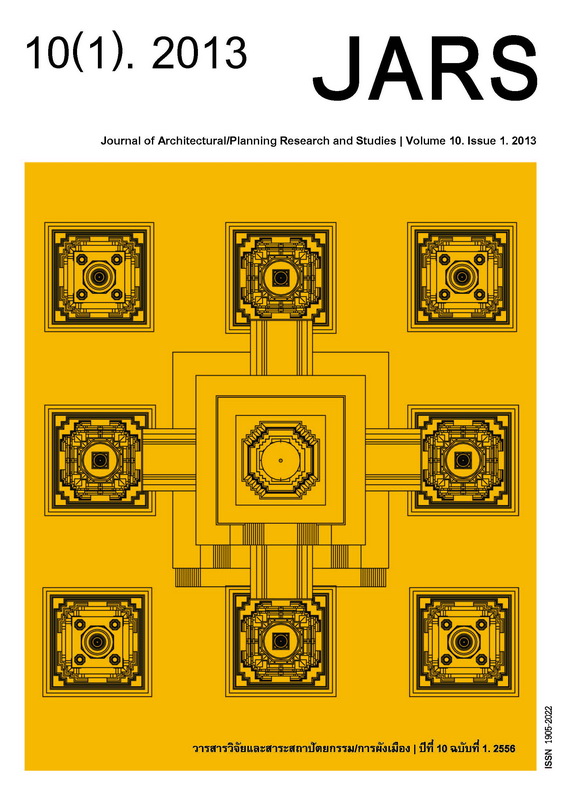Reconstruction of Archaeological Sites in Virtual Environment: Case Study of Wat Mahathat, Sukhothai Historical Park World Heritage
Main Article Content
Abstract
Historical tourism is a form of tourism that has become popular and has created revenue for the local communities. Tourists who are interested in visiting and learning from historical monuments are often met with disappointment due to the monument’s poor condition. They receive most of the information about the monuments from guidebooks or description plagues at the site. Therefore, they are unable to fully perceive monuments in their original state. Moreover, environmental factors such as temperature, sunlight, seasons and climate can sometimes interrupt the learning experience at the real location.
The objective of this research is to create a newtype of learning tool that reconstructs dilapidated historical monument in virtual environment. The case study is Wat Mahathat and it’s immediate physical surroundings at the Sukhothai Historical Park in Sukhothai province. This historical park is an important site for the study of architecture and archeology. However, the architecture in the Sukhothai Historical Park has suffered from tremendous damages overtime. In current state, there are only ruins of buildings, columns, remnants of chedis, Mondapus and Viharas. The archeological evidence, empirical studies and field survey inform the process of architectural analysis which is an important tool in estimating and finally reconstructing the original design of the architecture.
This learning tool will be a pivotal equipment that tourism organizations can further develop in order to enhance historical tourism prior to the actual location. Moreover, this research will be a part of standard setting for sustainable tourism.
Downloads
Article Details

This work is licensed under a Creative Commons Attribution-NonCommercial-NoDerivatives 4.0 International License.
All material is licensed under the terms of the Creative Commons Attribution 4.0 International (CC-BY-NC-ND 4.0) License, unless otherwise stated. As such, authors are free to share, copy, and redistribute the material in any medium or format. The authors must give appropriate credit, provide a link to the license, and indicate if changes were made. The authors may do so in any reasonable manner, but not in any way that suggests the licensor endorses you or your use. The authors may not use the material for commercial purposes. If the authors remix, transform, or build upon the material, they may not distribute the modified material, unless permission is obtained from JARS. Final, accepted versions of the paper may be posted on third party repositories, provided appropriate acknowledgement to the original source is clearly noted.
References
Shiratuddin, M. F. & Thabet, W. (2002). Virtual office walkthrough using a 3D game engine. International Journal of Design Computing, 4(1), 1329-7147.
Fukuda, T., Sakata, K., Yeo, W. & Kaga, A. (2006). Development and evaluation of a close-range view representation method of natural elements in a real time simulation for environmental design-shadow, grass, and water surface. Proceedings of the 24th International Conference eCAADe (Education and Research in Computer Aided Architectural Design in Europe), September 6-9, (pp. 58-65). Volos, Greece: University of Thessaly.
Jiratatsanakul, S. (2001). วัด: พุทธสถานสถาปัตยกรรมไทย [Wat: Buddha architecture of Thai architecture]. Pathumthani, Thailand: Thammasat Press.
Krairiksh, P. (1994). ประวัติศาสตร์ศิลปะสุโขทัย โครงสร้างที่ต้องเปลี่ยนแปลง [History of art in Sukhothai]. Siam Araya, 19, 15–42.
Leksukhum, S. (1996). ปราสาทแบบขอม เจดีย์ทรงปราสาทยอดแบบล้านนา แรงบันดาลใจของเจดีย์ทรงปราสาทยอดแบบสุโขทัย [Khmer-style Prasat, Lanna-style Prasat Peak of Chedi, Aspirations Sukhothai-style Prasat Peak of Chedi]. Art & Culture, 17, 142-144.
Leksukhum, S. (1998). เจดีย์ราย “ทรงปราสาทยอด” วัดราชบูรณะ จ. พระนครศรีอยุธยา [The subsidiary spire-topped prasat-type chedi, Wat Rachaburana, Ayutthaya]. Bangkok, Thailand: Amarin Printing & Publishing.
Leksukhum, S. (2001). เจดีย์บริวารประจำทิศทั้งแปดและพระศรีมหาธาตุ วัดพระศรีมหาธาตุ สุโขทัย [Wat Mahathat in Sukhothai historical park]. Muangboran Journal, 27, 44-50.
Leksukhum, S. (2008). โบราณสถานกับรูปแบบสันนิษฐานมรดกโลก สุโขทัย ศรีสัชนาลัย กำแพงเพชร [Ruins and reconstructed world heritage Sukhothai, Si Satchanalai and Kamphaeng Phet]. Bangkok, Thailand: Amarin Printing & Publishing.
Miliano, V. (1999). Unreality: Application of a 3D game engine to enhance the design, visualization and presentation of commercial real estate. Proceedings of VSMM’99 5th International Conference on Virtual Systems and Multimedia, September 1-3. Dundee, Scotland: University Of Abertay Dundee. Retrieved May 1, 2008, from http://www.unrealty.net/vsmm99/
Nindet, S. (1985). สถาปัตยกรรมสุโขทัย [Sukhothai architecture]. NAJUA: Journal of the Faculty of Architecture, Silpakorn University, 5, 55-62.
Rodboon, S. (1978). พุทธศิลป์สุโขทัย [Art of Buddha in Sukhothai]. Bangkok, Thailand: Aksorn Samai Printing.
Senyapili, B. (1997). Visualization of virtual architecture. Proceedings of the IEEE Conference on Information Visualisation, August 27-29, (pp. 260-266). Washington, DC, USA.
Shewasukthaworn, W. (2002). การศึกษารูปแบบสถาปัตยกรรมสุโขทัย กรณีศึกษาวัดมหาธาตุ ตำบลเมืองเก่า จังหวัดสุโขทัย [The Study of Sukhothai Architecture: A case study of Wat Mahathat, Sukhothai Province]. Master of Arts Thesis, Department of Architecture and Related Arts, Graduate School, Silpakorn University, Bangkok, Thailand.
Sunghitakul, A. (2006). อิโคโมสกับบทบาทของเครือข่ายเพื่อการอนุรักษ์และพัฒนามรดกทางวัฒนธรรมในประเทศไทย [ICOMOS and cultural heritage conservation network in Thailand]. Proceedings of Scientific Seminar: Cultural Heritage Conservation Network in Thailand and ICOMOS Thailand Annual Meeting 2004. Crown Property Bureau Conference Room, Ladawan Palace, Bangkok, Thailand: Amarin Printing & Publishing.
Suksawat, S., M.R. (1990). เจดีย์ทรงพุ่มข้าวบิณฑ์ [Lotus-bud Stupa]. Art & Culture, 11(8), 31-35.
The Finearts Department. (1969). รายงานการสำรวจและขุดแต่งบูรณะโบราณวัตถุสถานเมืองเก่าสุโขทัย พ.ศ. 2508-2512 [Report on the archaeological excavation restoration and reconstruction of Sukhothai: 1965-1969]. Bangkok, Thailand: The Fine arts Department.
Trenholme, D. & Smith, S. P. (2008). Computer game engines for developing first-person virtual environments. Journal of Virtual Reality, 12(3), 181-187.


